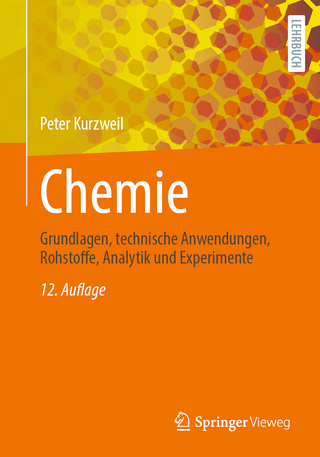
Translating Molecules into Medicines
Springer International Publishing (Verlag)
978-3-319-50040-9 (ISBN)
Shobha N. Bhattachar is a Director in Small Molecule Design and Development at Eli Lilly and Company. She has a Bachelor's degree in Pharmacy from Bangalore University, India, and a Master's degree in Pharmaceutical chemistry from the University of Kansas. Prior to joining Lilly, Bhattachar worked for eight years at Pfizer in Ann Arbor MI, in the Research Formulations group. She has authored/co-authored 15 publications covering wide ranging topics in the field of Pharmaceutical Sciences. Her current interests include the discovery-development interface, clinical candidate selection and developability assessment, clinical formulation development and biopharmaceutical aspects of drug product design. John S. Morrison earned his doctorate in physical organic chemistry from the University of Western Ontario studying the photochemical mechanisms responsible for the light-struck reaction in beer. After graduation John joined the Preformulation and Analytical Method Development group of Apotex Inc evaluating drug substances and novel drug product formulations. He then transitioned to the Discovery Pharmaceutics group of Bristol-Myers Squibb characterizing early drug candidates and establishing delivery strategies for a variety of dosing routes and molecular modalities. His current role bridges the discovery/development divide, collaboratively supporting multi-disciplinary discovery teams as well as determining and mitigating developability risks for potential clinical drug candidates. John has also led several AAPS committees and co-organizes the ACS Drug Design and Delivery webinar series.
Pharmaceutical Industry Performance.- Scope: productivity, success rates and costs.- Competitive landscape and regulatory requirements across different geographies. Drivers for increased efficiency, innovative approaches, and outlook for the next decade.- Unmet needs, major therapeutic areas of R&D focus and investment.- New Product Planning: Scope: General overview of patient profiles from different therapeutic areas, competitive intelligence, standard of care considerations, and impact of this information on the definition of NCE and product attributes and timelines.- Discovery Chemistry and Technologies: Scope: The druggable chemistry space, current targets of interest, new discovery technologies to define the binding pockets and compound attributes for a druggable target.- Challenges, examples of innovation and success.- Chemistry (Authors: TBD).- Biology, genomics, target validation.- In silico tools.- Early Discovery: Target of Interest through Lead: Scope: Effective and dynamic cross-functional collaboration between in vitro biology, chemistry, pharmacology, ADME, preformulation and toxicology to achieve Druggable Leads.- Application of in silico, in vitro and in vivo tools and translational approaches and strategies for integrated assessment and creation of druggable and developable lead scaffolds and assessing affinity and druggability at the scaffold level.- FBDD, druggable scaffolds, hit screening and making compounds.- Integrated assessment of Lead readiness, SRA.- Lead Optimization: Scope: Effective and dynamic cross-functional collaboration between in vitro biology, chemistry, pharmacology, ADME, preformulation and toxicology to achieve target engagement with a druggable candidate.- Candidate Selection.- Application of in silico, in vitro and in vivo tools and translational approaches and strategies for integrated assessment and identification of druggable and developable Clinical Candidate(s) with line of sight for clinical development.- Include description of tools, examples of application/case studies.- Developability including formulations and bio-relevant dissolution.- Chemistry scale up.- Early Clinical Development: Scope: Strategies for clinical trial study designs in the context of different therapeutic areas, clinical formulations, safety margins, biomarkers, tailored therapeutics, PK/PD modeling, controlled release formulations.- John Morrison working out the details of this section.- Alternative Drug Delivery: Scope: non-oral formulations based on patient/caregiver/marketing considerations.- Design, definition of compound attributes and development.- Regulatory aspects.- Industry Academia Collaboration.- Outlook for the Future.
| Erscheinungsdatum | 12.05.2017 |
|---|---|
| Reihe/Serie | AAPS Advances in the Pharmaceutical Sciences Series |
| Zusatzinfo | XXIV, 461 p. 101 illus., 81 illus. in color. |
| Verlagsort | Cham |
| Sprache | englisch |
| Maße | 155 x 235 mm |
| Themenwelt | Medizin / Pharmazie ► Pharmazie |
| Naturwissenschaften ► Chemie ► Technische Chemie | |
| Technik | |
| Schlagworte | Biomedical and Life Sciences • Chemische Technik • Competitive Intelligence • drug development • drug discovery • Industrial chemistry and chemical engineering • Medical Research • Pharmaceutical Sciences/Technology • Precision medicine • preformulation • Therapeutic |
| ISBN-10 | 3-319-50040-6 / 3319500406 |
| ISBN-13 | 978-3-319-50040-9 / 9783319500409 |
| Zustand | Neuware |
| Informationen gemäß Produktsicherheitsverordnung (GPSR) | |
| Haben Sie eine Frage zum Produkt? |
aus dem Bereich


